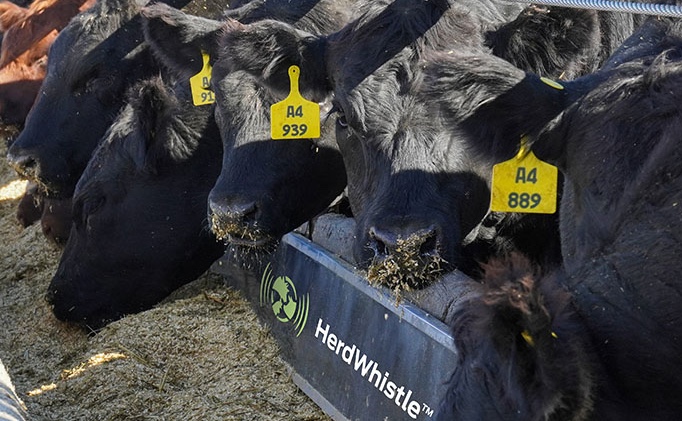HerdWhistle’s UHF solution is being adopted in North America, Australia and Europe in crowded feed lots
While short-range LF RFID is used to track cattle and other livestock in feedlots throughout much of the world, ultra-high frequency (UHF) RFID systems can provide more detailed views into the presence, health and wellbeing of animals.
Until recently, however, many cattle companies have found the UHF technology too high priced and challenging to install.
Canadian UHF RFID company HerdWhistle is expanding its global distribution partnerships as it grows its presence around the world, with what it says is an effective and low cost UHF solution. Most recently the technology firm signed a distribution partnership with Texas company Block Trust Network to expand the distributor’s livestock monitoring solutions.
A Varied Landscape of ID Requirements
The goal is to provide beef supply chain transparency. Block Trust network distributes HerdWhistle products including the company’s UHF RFID readers and antennas, and the Big Eye multispectral camera that tracks details related to the animal’s health, says Adam Morand, COO, HerdWhistle.
The landscape of RFID rollouts across the global beef industry varies according to countries. In Canada, where HerdWhistle operates, LF RFID has been mandated by law for many years.
In the U.S., cattle associations and cooperatives are working together to solve identification traceability challenges, often provided by LF RFID, while a number of groups now are using UHF tags as well.
In Europe, some countries have mandated UHF use. Australia, like Canada, is using LF by law, but the UHF standard products are being voluntarily adopted.
The Problem – Traceability for Thousands of Animals
For feed lots, tracking thousands of head of cattle is highly challenging, even with a large staff of workers. Many cattle operations have been struggling to retain enough labor.
When cattle have LF tags attached to their ears, workers must touch the tag with a reader wand, which can be disruptive and unrealistic in the crowded, fast paced environments.
HerdWhistle was launched in 2019 by a group of technologists to serve the beef cattle industry, by gaining automated visibility into feed lots. Morand compares the efforts in a feedlot to the work in progress tracking required at a factory, but in this case, the products are cattle.
“At the end of the day, when you go to a feed lot it’s just like any other manufacturing facility: there’s an input there’s an output you’re trying to minimize loss,” said Morand.
Environmental Challenges
Any solution needed to be low cost due to the razor-thin profit margin the industry faces, he says.
Once HerdWhistle decided on UHF RFID, with tags in cow ears and antennas mounted at key locations around the feed lots, they looked for off-the-shelf readers.
But feedlots offer environmental challenges such as harsh weather conditions, the high presence of water and dirt, and the mobility and unpredictability of animals weighing more than a thousand pounds.
Low-cost Technology
So HerdWhistle designed its own RFID antenna that could sustain the environment and capture tag reads at a distance, in high volume, accurately and in diverse locations, such as a trough.
One version is a long panel that can be mounted overhead, indoors or outdoors. Another version is a coax cable in segments up to four meters each, with built-in antenna. The antennas can capture thousands of cattle tags at a time.
Additionally, HerdWhistle developed several kinds of handheld readers such as an RFID gun that can read tags from a distance up to 100 feet away. These readers are commonly used by workers seeking a specific cow that has not been detected at the trough and may be sick or injured.
Another handheld—the processing scanner—will read both low frequency and UHF and then connect them together, used for inducting the animals such as when they arrive at the feedlot.
Cameras to Detect Health
HerdWhistle offers its BigEye TM multi-spectral camera to take 3D measurements of an animal that comes within range of the reader, to determine its live weight or carcass composition. The infrared camera within the BigEye TM enables pixelated images in real time that enables animals at risk of disease or morbidity to be identified.
The system then links the animal tag’s RFID data to the unique ID. Animals identified as “at risk” then can easily be located to be removed to a hospital pen and treated with medication. Users typically deploy the thermal cameras at choke points such as transfer areas or on ramps or loading docks as animals are moved, Morand explains.
Among the scientists at HerdWhistle, Morand says, “We have an entire body of knowledge related to infrared thermography and thermal imaging that allows us to look at the animal, take the images and basically diagnosis and categorize (their health).”
Return on Investment
HerdWhistle and partnering with shareholder Alpha Phenomics Inc. have over 30 patents related to the science behind infrared thermography and the analytics associated with the video capture, Morand says.
For feedlots that have adopted the solution, the return on investment is centered around ensuring enough visibility into operations onsite to ensure healthier cattle. The technology works with other livestock such as sheep and pigs.
“The feedlots have 24/7 monitoring, including which animals are at risk,” and which are the highest value, so that response can be provided based on the data, according to Morland. And by tracking the health of animals, the operators can be more strategic as to how vaccinations or antibiotics are applied.
Key Takeaways:
- HerdWhistle is expanding its UHF RFID and camera-based system for tracking beef cattle, their behavior and health.
- The system serves the cattle industry at a time when labor is down and the demand for visibility is up.


